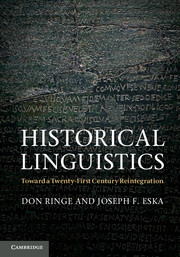Book contents
- Frontmatter
- Contents
- Figures
- Tables
- Preface
- Acknowledgments
- Introduction
- 1 The nature of human language and language variation
- 2 Language replication and language change
- 3 Language change in the speech community
- 4 Language contact as a source of change
- 5 Sound change
- 6 The evolution of phonological rules
- 7 Morphology
- 8 Morphological change
- 9 Syntactic change
- 10 Reconstruction
- 11 Beyond comparative reconstruction
- Appendix: Recovering the pronunciation of dead languages: types of evidence
- References
- General index
- Index of languages and families
1 - The nature of human language and language variation
Published online by Cambridge University Press: 05 February 2013
- Frontmatter
- Contents
- Figures
- Tables
- Preface
- Acknowledgments
- Introduction
- 1 The nature of human language and language variation
- 2 Language replication and language change
- 3 Language change in the speech community
- 4 Language contact as a source of change
- 5 Sound change
- 6 The evolution of phonological rules
- 7 Morphology
- 8 Morphological change
- 9 Syntactic change
- 10 Reconstruction
- 11 Beyond comparative reconstruction
- Appendix: Recovering the pronunciation of dead languages: types of evidence
- References
- General index
- Index of languages and families
Summary
This chapter is, in effect, background reading; it presents our views about the nature of human language in the hope of making our perspective on language change more easily intelligible. We have not presented a survey of views on any of the subjects covered here because it is not our purpose to “teach the controversy” about the origin of signed languages, for example, or the extent to which apes can be taught to use human language. In each case we have presented the view that we believe is correct (or is most likely to prove correct in the long run). It will be seen that our perspective falls squarely within the generative tradition.
Students with considerable background in the cognitive basis of human language, as well as students whose primary concern is historical linguistics narrowly defined, may prefer to skip this chapter or postpone reading it until later.
Language is species-specific
“Language,” as linguists understand the term, is a property of the human species, both unique to humans and universal among them. That seems obvious, but because it has important consequences it merits at least a brief discussion.
- Type
- Chapter
- Information
- Historical LinguisticsToward a Twenty-First Century Reintegration, pp. 7 - 27Publisher: Cambridge University PressPrint publication year: 2013

